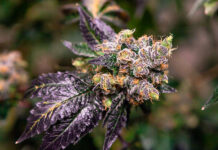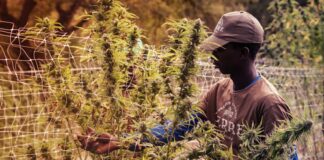
“Blunt Truths” tells the story of marijuana prohibition.
The story so far: Racism lies at the heart of America’s marijuana prohibition. For the first three years of Harry Anslinger’s tenure as Commissioner of the Federal Bureau of Narcotics (FBN), he viewed marijuana as a local problem limited to America’s Southwest. But, when he feared that marijuana was spreading into “white culture,” he made marijuana prohibition his priority. Lacking a Constitutional basis to prohibit marijuana use, Anslinger had to find another way. He did.
On June 14, 1937, H.R. 6906 – The Marijuana Tax Act of 1937 – was presented to the House of Representatives for unanimous consent. Just one question was raised before voting took place a mere 30 minutes into the proceedings: “Did anyone consult the American Medical Association (AMA)?”
In fact, the AMA had been consulted. Dr. William C. Woodward, the doctors association’s general counsel, had testified before the Ways and Means Committee on May 4, 1937. Woodward was no stranger to Congress, to the legislative process, or the subject of legislating narcotics given that in 1914 Woodward had helped draft the Harrison Narcotics Act.
Ironically, Woodward was there to oppose regulating cannabis. He began his testimony by pointing out that what the committee was doing with its Tax Act was absurd. They were basing their actions on a word: “The term ‘marihuana’ is a mongrel word that has crept into this country over the Mexican border and has no general meaning, except as it relates to the use of cannabis preparations for smoking. It is not recognized in medicine, and I might say that it is hardly recognized even in the Treasury Department.”
The term ‘marihuana’ is a mongrel word that has crept into this country over the Mexican border and has no general meaning, except as it relates to the use of cannabis preparations for smoking. It is not recognized in medicine. Click To Tweet
Dr. Woodward pointed directly at the 800-pound gorilla in the room: racism. The AMA saw real medicinal value in cannabis. They did not want to see it prohibited as the Tax Act clearly intended.
Back to June 13, 1937. The question was asked: “Did anyone consult the AMA?” Democratic Kentucky Rep. Fred Vinson, who later became a U.S. Supreme Court justice, said while answering for the Ways and Means Committee: “Yes, we have. A Dr. Wharton [the mistaken pronunciation of Woodward’s last name] and the AMA are in complete agreement.” Just like that, another lie became “truth;” Congressionally accepted “truth.” It was a testament to Harry Anslinger’s bureaucratic genius.
Anslinger understood how to get his way in Washington, D.C. He knew how to motivate legislators to do what he wanted. He knew that lots of those legislators were as racist as he was — and therefore willing to ignore the truth in favor of a racist lie. This is vitally important because it proved to Anslinger that he could win this way whenever he wanted to.
Within 24 hours of Franklin Delano Roosevelt signing the Marijuana Tax Act into law on Oct. 2, 1937, “the FBI and Denver police raided the Lexington Hotel and arrested Samuel R. Caldwell, 58, an unemployed laborer, and Moses Baca, 26.” Caldwell went into the history books as America’s first criminal marijuana seller while his customer, Baca, got nailed for possession. They would not be alone for long.
Cannabis Prosecution Begins
In “Cannabis: A History,” author Martin Booth pointed out how the law of unintended consequences eventually caught up with Anslinger. He had been so successful in selling marijuana as an “addictive drug which produces in its users insanity, criminality, and death,” that defense attorneys representing clients charged with murder began to use Anslinger’s to build their case. They were successful, too.
Anslinger bumped into another unexpected problem that cannabis prohibition created. According to Booth, controlling cannabis was not like controlling heroin. Cannabis grew prolifically and required minimal processing, unlike heroin. Heroin, Anslinger admitted in private, “was far more dangerous and more easily controlled. Yet marijuana had served its purpose. The FBN’s budget was substantially increased … .”
Through the 1940s, Anslinger used his newly acquired law enforcement muscle to go after jazz musicians such as trumpet player Louis Armstrong, drummer Gene Krupa, and actor Robert Mitchum. As the 1940s waned, heroin addiction soared and became a very real problem — a lot more real than any “marijuana addiction” problem. With World War II over, the United States settled into a cold war with the Soviet Union and a hot-and-cold war with China.
In his book “The Traffic In Narcotics,” Anslinger goes on at length — quoting lots of unsourced data — to prove that not only was China growing an incredible amount of heroin, but that the nation intended to inundate America with it. Booth pointed out that Anslinger knew Chinese heroin wasn’t flooding America’s streets. The larger problem to Anslinger was still cannabis: the drug that previously turned its users into raging killers now “could turn America into a nation of compliant pacifists” only too happy to become addicts of Chinese heroin.
Marijuana, Anslinger without an ounce of evidence insisted was the gateway drug that led inevitably to heroin addiction. Now having enforcement power, Anslinger wanted it to have teeth.
Democratic Louisiana Rep. Hale Boggs stepped forward with legislation, the Boggs Act, which took the tax evasion penalties from the Marijuana Tax Act and unified them across the country as straight possession and sales penalties with considerably longer jail sentences. First offenses drew two to five years in prison, second offenses five to 10 years, and third offenses 10 to 20 years — all with mandatory $2,000 fines.
Though the Boggs Act, signed into law on November 2, 1951, by Democratic President Harry Truman, produced more than 500 arrests in its first two months. Before long, Anslinger still felt the punishments weren’t punitive enough. As Larry Sloman put it in “Reefer Madness: A History of Marijuana,” Anslinger followed the script he’d written himself: Democratic Sen. Price Daniel of Texas sponsored the legislation that would become the Narcotics Control Act of 1956.
During the hearings, Daniel asked Anslinger whether “the use of marijuana leads many people eventually to the use of heroin and the drugs that do cause them complete addiction?” Anslinger replied without equivocation: “If used over a long period, it does lead to heroin addiction.”
Another profound lie had just become fact. An official fact.
Next: How To Manufacture A “War On Drugs”
Follow the “Blunt Truths” series:
- Introduction: How One Man Turned the Law and Society Against Weed
- Chapter 1: Harry Anslinger, the Prohibition Cop with Nothing to Prohibit
- Chapter 2: What Stoners Know that Harry Anslinger Didn’t Care to Know
- Chapter 3: Cannabis was Accepted Before Harry Anslinger
- Chapter 4: The Great Hemp Conspiracy
- Chapter 5
- Chapter 6: All Publicity is Good Publicity
- Chapter 7: Harry Anslinger Goes Hollywood
- Chapter 8: Fiorello La Guardia Debunks Anslinger’s Myths
Featured Image: Photo by Hédi Benyounes on Unsplash















